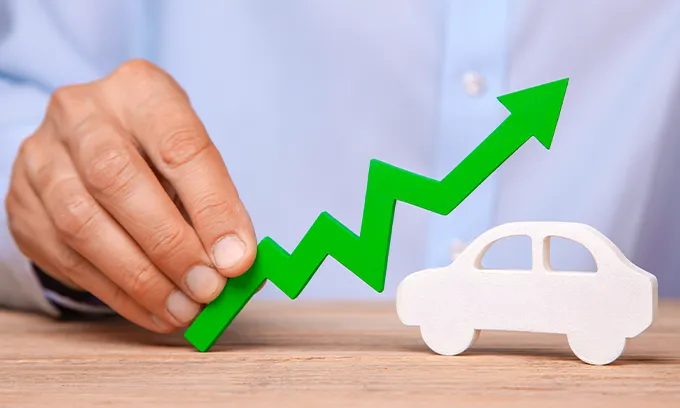Car insurance can provide financial peace of mind in the event of an accident. If your car is damaged, or if you damage somebody else’s vehicle or property while driving, car insurance can help cover the cost of repairs.
Usually, car insurance premiums increase each year, which can seem counterintuitive, since generally the value of a used car decreases as it ages.
So why do car insurance premiums go up, and are there steps you can take to keep them as low as possible?
Below, we explore the answers to these questions. But let us start with a brief overview of how car insurance providers calculate their customers’ premiums.
What is a car insurance premium?
A car insurance premium is the price you pay for car insurance, which provides financial compensation should your vehicle incur damage, or if you damage another person’s property or car while driving.
Car insurance providers calculate the size of their premiums based on factors including car values, drivers’ risk profiles, and cover levels:
The car you drive
The car you drive has a big effect on the cost of your premiums. Obviously, a new, expensive, powerful European sports car is going to be more expensive to insure than a 10-year-old family runabout. Any finance owing on a car, along with customisations or mods, can also increase your premiums.
Your level of cover
Aside from the ACC motor vehicle levy, which comprises part of the cost of your car's rego and provides financial cover if the driver hurts somebody in a road accident, there are three main categories of car insurance:
- Third-party: usually the cheapest level of insurance, it provides financial cover only for damage caused to other people’s property, such as cars or homes.
- Third-party, fire & theft: mid-price car insurance that covers a car if stolen or damaged by fire, in addition to third-party cover.
- Comprehensive car insurance: the most expensive level of car insurance, it covers accidental damage to a car, regardless of who is at fault, plus third-party, fire & theft coverage.
Drivers’ risk profiles
When setting the price of a policy, a car insurance provider will calculate a customer’s risk profile, to assess their likelihood of making a claim. And, the greater the risk, the higher the premium price. Risk profiles are based on factors such as:
- The age and gender of a car’s listed drivers: younger drivers are deemed a higher risk, especially males under the age of 25, and therefore incur higher premiums. Seniors, too, can pay higher premiums.
- Where the car is parked: if a car is parked in a locked garage in a quiet suburb, it’s going to be deemed a lower risk than if it’s parked on a street in an urban area with a higher crime rate.
- Driving/claims history: if you’ve committed any serious driving offences, or made car insurance claims in the past few years, these can adversely affect your premiums.
Why do car insurance premiums go up?
Multiple factors affect the cost of car insurance, which can lead to annual premium increases. These include:
General inflation: since the late 1960s, New Zealand has experienced consistent price inflation. As the costs of repairing or replacing damaged cars increase, so do premiums.
Extreme weather events: floods and other severe weather events can lead to a steep rise in car insurance claims, which can cause insurance providers to increase their premiums to cover costs.
Changes to insurance providers’ general risk assessments: insurance providers are constantly reassessing risk factors, from crime to climate. Depending on where you live, this means your premiums can increase due to perceived increased risks.
Changes in personal details: as we mention above, drivers’ ages can affect policy costs. Moving home, or changing how you use your car, for example starting a new job that involves a long commute, can also cause the cost of your insurance to increase.
My car’s losing value, so why is my premium going up?
Unless you have a prestige, collectable car, the market value of your vehicle will depreciate as it ages. However, you may find that your car insurance premiums still rise. This is because the purpose of car insurance isn’t to simply replace your vehicle like for like.
All levels of optional insurance, from third-party through to comprehensive, cover damage to other people’s property and vehicles. Also, most car insurance claims aren’t for the replacement of written-off vehicles. Instead, they are for repair costs, which are subject to inflationary pressures.
So along with the other general reasons why premiums tend to increase, as listed above, despite the value of your car depreciating annually, you can expect your premiums to head in the other direction.
How can I reduce my car insurance premiums?
There are steps you can take that could lower the price of your policy:
- Change your level of cover: this could include removing extras, such as excess-free glass cover or roadside assist, increasing your excess, or changing from agreed value to market value.
- Improve your security by parking your car overnight in a locked garage, or fitting anti-theft systems.
- Paying your premium yearly, as paying by instalments usually incurs a surcharge.
- Use your car less, for example by using public transport for your commute.
- Bundling your car insurance with other policies, such as home and contents, can often earn a multi-policy discount.
- Compare car insurance providers. If you’ve not compared prices between different providers, you could be missing out on a better deal.







